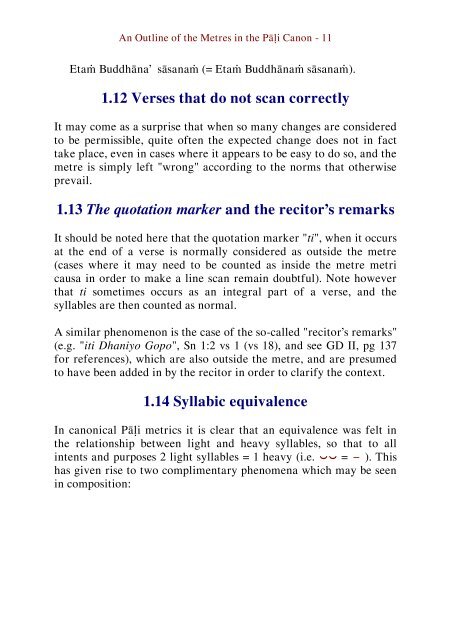An Outline of the Metres in the Pāḷi Canon
A concise but thorough explanation of the metres that are found in the Pāli canon, along with examples and glossary.
A concise but thorough explanation of the metres that are found in the Pāli canon, along with examples and glossary.
You also want an ePaper? Increase the reach of your titles
YUMPU automatically turns print PDFs into web optimized ePapers that Google loves.
<strong>An</strong> <strong>Outl<strong>in</strong>e</strong> <strong>of</strong> <strong>the</strong> <strong>Metres</strong> <strong>in</strong> <strong>the</strong> <strong>Pāḷi</strong> <strong>Canon</strong> - 11<br />
Etaṁ Buddhāna’ sāsanaṁ (= Etaṁ Buddhānaṁ sāsanaṁ).<br />
1.12 Verses that do not scan correctly<br />
It may come as a surprise that when so many changes are considered<br />
to be permissible, quite <strong>of</strong>ten <strong>the</strong> expected change does not <strong>in</strong> fact<br />
take place, even <strong>in</strong> cases where it appears to be easy to do so, and <strong>the</strong><br />
metre is simply left "wrong" accord<strong>in</strong>g to <strong>the</strong> norms that o<strong>the</strong>rwise<br />
prevail.<br />
1.13 The quotation marker and <strong>the</strong> recitor’s remarks<br />
It should be noted here that <strong>the</strong> quotation marker "ti", when it occurs<br />
at <strong>the</strong> end <strong>of</strong> a verse is normally considered as outside <strong>the</strong> metre<br />
(cases where it may need to be counted as <strong>in</strong>side <strong>the</strong> metre metri<br />
causa <strong>in</strong> order to make a l<strong>in</strong>e scan rema<strong>in</strong> doubtful). Note however<br />
that ti sometimes occurs as an <strong>in</strong>tegral part <strong>of</strong> a verse, and <strong>the</strong><br />
syllables are <strong>the</strong>n counted as normal.<br />
A similar phenomenon is <strong>the</strong> case <strong>of</strong> <strong>the</strong> so-called "recitor’s remarks"<br />
(e.g. "iti Dhaniyo Gopo", Sn 1:2 vs 1 (vs 18), and see GD II, pg 137<br />
for references), which are also outside <strong>the</strong> metre, and are presumed<br />
to have been added <strong>in</strong> by <strong>the</strong> recitor <strong>in</strong> order to clarify <strong>the</strong> context.<br />
1.14 Syllabic equivalence<br />
In canonical <strong>Pāḷi</strong> metrics it is clear that an equivalence was felt <strong>in</strong><br />
<strong>the</strong> relationship between light and heavy syllables, so that to all<br />
<strong>in</strong>tents and purposes 2 light syllables = 1 heavy (i.e. ⏑⏑ = − ). This<br />
has given rise to two complimentary phenomena which may be seen<br />
<strong>in</strong> composition:

















